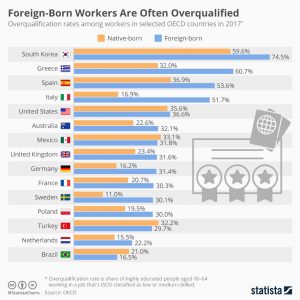In many developed countries, a considerable share of workers is overqualified for their jobs.
Greece (60.7 percent), Spain (53.6 percent) and Italy (51.7 percent) are notable examples of Southern European countries where the foreign-born population has a far higher overqualification rate than the native-born population where the share is 32 percent, 36.9 percent, and 16.9 percent respectively.
The issue has become increasingly common in recent years, most evident in economies with competitive job markets. While it can, of course, result in positive effects for some organizations such as an employee performing at a higher level, it can also result in higher salary expectations, a lower level of satisfaction and a higher chance of a person leaving their job. The OECD definition of the overqualification rate is the share of the highly educated who are working in a job that is ISCO-classified as low or medium skilled.
Over a third of highly educated immigrants in employment across OECD countries are overqualified for their jobs with the exact rate differing significantly between countries. Excluding Portugal, that share is particularly high across Southern Europe where many highly educated migrants are in low and medium-skilled jobs. That disparity isn’t just defined to Southern Europe as the following infographic shows.
South Korea has the highest share of overqualification among a native-born workforce and even more interestingly, its foreign-born population has an even greater share of overqualification at 74.5 percent. In the U.S. and Mexico, native and foreign-born workers are equally likely to be too skilled for their jobs.
source: statista

Ask me anything
Explore related questions





